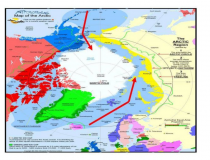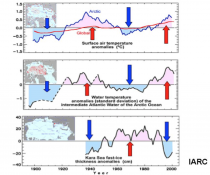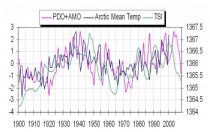The New York Times did a story on arctic ice this past week.
See in this video how Tony Heller responds to this story
See in this Icecap story how the changes are cyclical as Tony shows with data and news accounts including the New York Times.
We showed how the water from the Atlantic and Pacific enter the arctic underneath the floating ice. When the Atlantic and Pacific are in their warm modes, this leads to thinning ice and reduced summer coverage.
The UAF IARC showed how warm water in the Atlantic warms the arctic and reduces ice.
We showed how the Atlantic and Pacific combined warmth and coolness corresponds with arctic temperatures.
In the record-setting (since satellite monitoring began in 1979) summer melt season of 2007, NSIDC scientists noted the importance of both oceans in the arctic ice.
“One prominent researcher, Igor Polyakov at the University of Fairbanks, Alaska, points out that pulses of unusually warm water have been entering the Arctic Ocean from the Atlantic, which several years later are seen in the ocean north of Siberia. These pulses of water are helping to heat the upper Arctic Ocean, contributing to summer ice melt and helping to reduce winter ice growth.
Another scientist, Koji Shimada of the Japan Agency for Marine-Earth Science and Technology, reports evidence of changes in ocean circulation in the Pacific side of the Arctic Ocean. Through a complex interaction with declining sea ice, warm water entering the Arctic Ocean through Bering Strait in summer is being shunted from the Alaskan coast into the Arctic Ocean, where it fosters further ice loss.
Many questions still remain to be answered, but these changes in ocean circulation may be important keys for understanding the observed loss of Arctic sea ice.”
Dr. Willie Soon shows a much better correlation of solar TSI and arctic temperatures than CO2.








